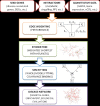A novel network analysis approach reveals DNA damage, oxidative stress and calcium/cAMP homeostasis-associated biomarkers in frontotemporal dementia
- PMID: 29020091
- PMCID: PMC5636111
- DOI: 10.1371/journal.pone.0185797
A novel network analysis approach reveals DNA damage, oxidative stress and calcium/cAMP homeostasis-associated biomarkers in frontotemporal dementia
Abstract
Frontotemporal Dementia (FTD) is the form of neurodegenerative dementia with the highest prevalence after Alzheimer's disease, equally distributed in men and women. It includes several variants, generally characterized by behavioural instability and language impairments. Although few mendelian genes (MAPT, GRN, and C9orf72) have been associated to the FTD phenotype, in most cases there is only evidence of multiple risk loci with relatively small effect size. To date, there are no comprehensive studies describing FTD at molecular level, highlighting possible genetic interactions and signalling pathways at the origin FTD-associated neurodegeneration. In this study, we designed a broad FTD genetic interaction map of the Italian population, through a novel network-based approach modelled on the concepts of disease-relevance and interaction perturbation, combining Steiner tree search and Structural Equation Model (SEM) analysis. Our results show a strong connection between Calcium/cAMP metabolism, oxidative stress-induced Serine/Threonine kinases activation, and postsynaptic membrane potentiation, suggesting a possible combination of neuronal damage and loss of neuroprotection, leading to cell death. In our model, Calcium/cAMP homeostasis and energetic metabolism impairments are primary causes of loss of neuroprotection and neural cell damage, respectively. Secondly, the altered postsynaptic membrane potentiation, due to the activation of stress-induced Serine/Threonine kinases, leads to neurodegeneration. Our study investigates the molecular underpinnings of these processes, evidencing key genes and gene interactions that may account for a significant fraction of unexplained FTD aetiology. We emphasized the key molecular actors in these processes, proposing them as novel FTD biomarkers that could be crucial for further epidemiological and molecular studies.
Conflict of interest statement
Figures





Similar articles
-
Brain atrophy over time in genetic and sporadic frontotemporal dementia: a study of 198 serial magnetic resonance images.Eur J Neurol. 2015 May;22(5):745-52. doi: 10.1111/ene.12675. Epub 2015 Feb 12. Eur J Neurol. 2015. PMID: 25683866 Free PMC article.
-
Poly(GR) in C9ORF72-Related ALS/FTD Compromises Mitochondrial Function and Increases Oxidative Stress and DNA Damage in iPSC-Derived Motor Neurons.Neuron. 2016 Oct 19;92(2):383-391. doi: 10.1016/j.neuron.2016.09.015. Epub 2016 Oct 6. Neuron. 2016. PMID: 27720481 Free PMC article.
-
Frontotemporal dementia-related gene mutations in clinical dementia patients from a Chinese population.J Hum Genet. 2016 Dec;61(12):1003-1008. doi: 10.1038/jhg.2016.92. Epub 2016 Jul 21. J Hum Genet. 2016. PMID: 27439681
-
Imaging and fluid biomarkers in frontotemporal dementia.Nat Rev Neurol. 2017 Jul;13(7):406-419. doi: 10.1038/nrneurol.2017.75. Epub 2017 Jun 16. Nat Rev Neurol. 2017. PMID: 28621768 Review.
-
The Underestimated Role of Iron in Frontotemporal Dementia: A Narrative Review.Int J Mol Sci. 2024 Dec 3;25(23):12987. doi: 10.3390/ijms252312987. Int J Mol Sci. 2024. PMID: 39684697 Free PMC article. Review.
Cited by
-
SEMgsa: topology-based pathway enrichment analysis with structural equation models.BMC Bioinformatics. 2022 Aug 17;23(1):344. doi: 10.1186/s12859-022-04884-8. BMC Bioinformatics. 2022. PMID: 35978279 Free PMC article.
-
Translation of dipeptide repeat proteins from the C9ORF72 expanded repeat is associated with cellular stress.Neurobiol Dis. 2018 Aug;116:155-165. doi: 10.1016/j.nbd.2018.05.009. Epub 2018 May 22. Neurobiol Dis. 2018. PMID: 29792928 Free PMC article.
-
Uncoupling protein 4 (UCP4) gene variability in neurodegenerative disorders: further evidence of association in Frontotemporal dementia.Aging (Albany NY). 2018 Nov 13;10(11):3283-3293. doi: 10.18632/aging.101632. Aging (Albany NY). 2018. PMID: 30425186 Free PMC article.
-
The Interplay between Ca2+ Signaling Pathways and Neurodegeneration.Int J Mol Sci. 2019 Nov 28;20(23):6004. doi: 10.3390/ijms20236004. Int J Mol Sci. 2019. PMID: 31795242 Free PMC article. Review.
-
Strategies for using mathematical modeling approaches to design and interpret multi-organ microphysiological systems (MPS).APL Bioeng. 2019 Jun 20;3(2):021501. doi: 10.1063/1.5097675. eCollection 2019 Jun. APL Bioeng. 2019. PMID: 31263796 Free PMC article. Review.
References
-
- Gorno-Tempini ML, Hillis AE, Weintraub S, Kertesz A, Mendez M, et al. (2011) Classification of primary progressive aphasia and its variants. Neurology 76: 1006–1014. doi: 10.1212/WNL.0b013e31821103e6 - DOI - PMC - PubMed
-
- Rohrer JD, Warren JD (2011) Phenotypic signatures of genetic frontotemporal dementia. Current opinion in neurology 24: 542–549. doi: 10.1097/WCO.0b013e32834cd442 - DOI - PubMed
-
- Manolio TA, Collins FS, Cox NJ, Goldstein DB, Hindorff LA, et al. (2009) Finding the missing heritability of complex diseases. Nature 461: 747–753. doi: 10.1038/nature08494 - DOI - PMC - PubMed
MeSH terms
Substances
LinkOut - more resources
Full Text Sources
Other Literature Sources
Miscellaneous

